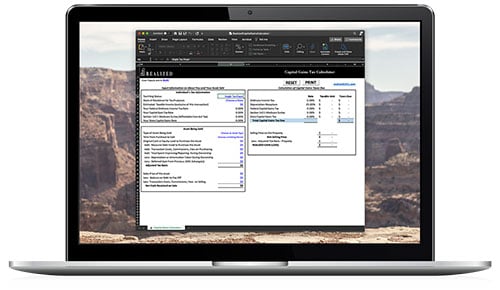
A 1031 exchange is a tax-advantaged investment strategy that many accredited investors turn to to preserve their wealth. One question some may ask is: “Does a 1031 exchange eliminate capital gains?” The answer is no — the like-kind exchange doesn’t eliminate your tax liability after making a profit during a property sale. Instead, this strategy defers capital gains taxes.
What does this process entail? What happens to the capital gains in the future? Realized 1031 has shared a guide to help you stay informed.
Refresher on 1031 Exchanges
Named after Section 1031 of the Revenue Code, a 1031 exchange allows investors to exchange real property for another asset of similar characteristics. Since there is no sale during the swap, there is no taxable event. This condition allows you to defer capital gains taxes until another taxable event occurs.
The IRS has set many rules surrounding the 1031 exchange to discourage abuse and maintain the integrity of the exchange. Key rules include the following.
- Like-kind Properties: The assets must be similar. More specifically, these properties must have been held for investment or business purposes.
- Equal or Greater Value: You must choose a replacement property that matches or exceeds the value of the relinquished property. Any leftover proceeds will be considered boot.
- Arm’s Length Transaction: Working with a qualified intermediary is necessary to prevent you from gaining direct control of the proceeds.
- Timeline Requirements – Identify the replacement property within 45 days of sale, and complete the exchange within 180 days.
What Happens to 1031 Exchange Capital Gains?
When you complete a 1031 exchange, your capital gains taxes are not erased, they’re postponed. The deferred gains carry over to the replacement property, adjusting your cost basis. If you eventually sell the new property without doing another exchange, the accumulated capital gains from all previous properties become taxable. When this happens, the tax liability may be significant. Working with tax professionals and evaluating eligible strategies may help manage this tax exposure.
However, if the property is held until death, your heirs may receive a step-up in basis, which resets the value of the asset. This may eliminate the deferred gain—though estate tax rules may still apply.
Potential Benefits of a 1031 Exchange
While the like-kind exchanges don’t eliminate capital gains entirely, they may offer several benefits for investors—although outcomes depend on individual circumstances and market conditions.
- Tax Deferral: Delaying capital gains tax payments, you may free up more capital to reinvest, which could support portfolio growth. Always consider cash flow and liquidity implications.
- Diversify Portfolio: Using an exchange to acquire properties in different locations or asset types may support diversification efforts—though diversification is not guaranteed and depends on market dynamics.
- Passive Income: 1031 exchanges can also be ended by entering Delaware Statutory Trusts. These investment vehicles allow for hands-off involvement, giving you truly passive income. However, income from DSTs varies and isn’t assured.
- Step-up in Basis: As mentioned, a 1031 exchange property gains a step-up in basis for your heirs. These individuals may no longer have to pay capital gains taxes since the new cost basis of the property will be its value upon your death. Estate and inheritance tax rules should also be reviewed.
Risks and Considerations of a 1031 Exchange
While 1031 exchanges offer tax deferral potential, they also involve regulatory, financial, and market-related risks that investors must carefully consider:
-
Strict IRS Timelines: To qualify for tax deferral, replacement properties must be identified within 45 days and acquired within 180 days of the relinquished property’s sale. Missing these deadlines may disqualify the exchange, resulting in an immediate tax event.
-
Boot and Partial Tax Liability: If the replacement property is of lesser value or if any cash or non-like-kind property is received (known as “boot”), a portion of the capital gains may become immediately taxable. Accurately structuring the transaction is essential to maintain full deferral.
-
Reduced Basis Carryover: The replacement property inherits the adjusted basis of the relinquished property, including prior depreciation. This can result in lower depreciation deductions and increased tax exposure upon eventual sale.
-
Limited Liquidity and Flexibility: Investing in like-kind assets—especially structured options like DSTs—may limit access to funds and restrict future decision-making, including refinancing or early exit from the investment.
Wrapping Up: Like-Kind Exchange Capital Gains Basics
1031 exchanges do not eliminate capital gains taxes. This investment strategy is for deferring capital gains tax payments until a taxable event happens, like the sale of the replacement property. Understanding this timeline—along with your adjusted basis and potential tax burden—allows for more informed decision-making and planning.
The tax and estate planning information offered by the advisor is general in nature. It is provided for informational purposes only and should not be construed as legal or tax advice. Always consult an attorney or tax professional regarding your specific legal or tax situation.
Article written by: Story Amplify. Story Amplify is a marketing agency that offers services such as copywriting across industries, including financial services, real estate investment services, and miscellaneous small businesses.
Sources:
https://www.investopedia.com/terms/s/stepupinbasis.asp
https://www.irs.gov/pub/irs-news/fs-08-18.pdf
https://www.investopedia.com/financial-edge/0110/10-things-to-know-about-1031-exchanges.aspx


